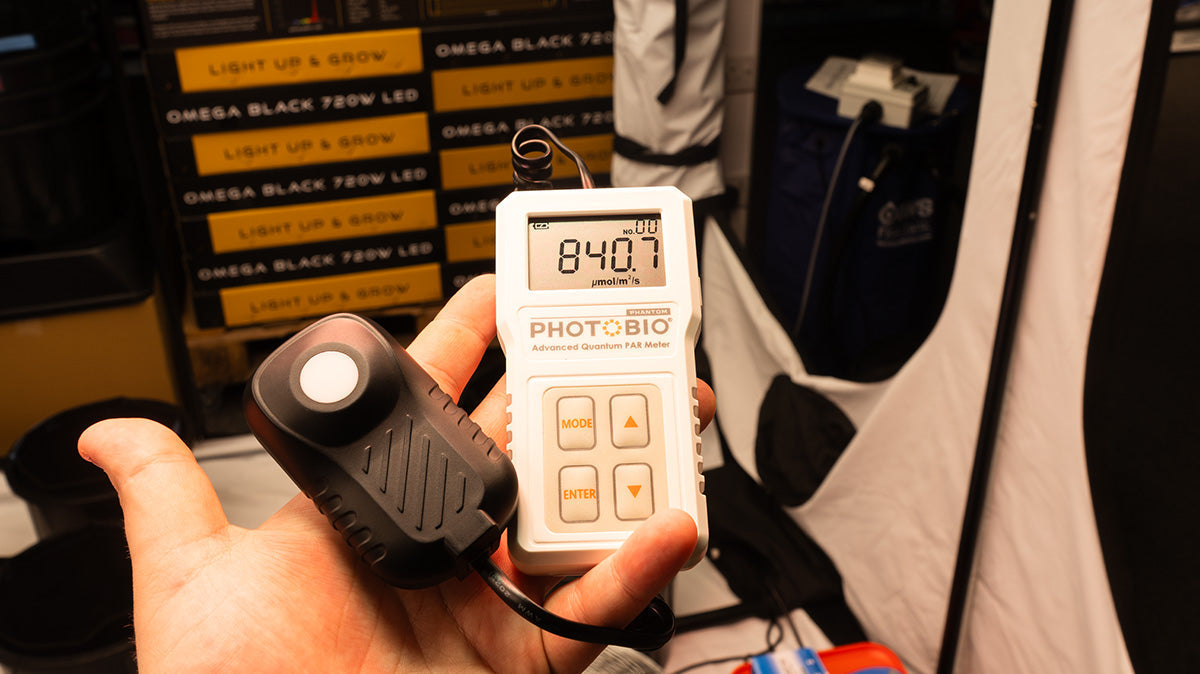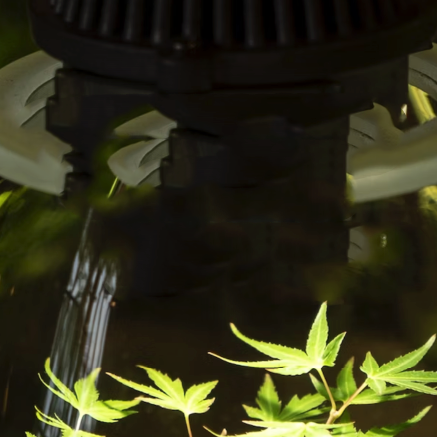Why Every Grower Needs a PAR Meter – Maximise LED Efficiency
Unlock the Full Potential of Your LED Grow Lights with a PAR Meter
PAR (Photosynthetically Active Radiation) is the light spectrum (400-700 nm) that plants use for photosynthesis. Unlike lux or lumens, which measure brightness for human vision, a PAR meter measures the actual light intensity that plants absorb, with specific attention to wavelengths in the range of 400-700 nm. This ensures that plants receive the right amount of light at every growth stage, maximising yield and energy efficiency. Many growers rely on manufacturer recommendations or guesswork when adjusting their grow lights. This often leads to inefficient lighting, wasted energy, and inconsistent plant development. A quantum PAR sensor meter eliminates uncertainty and provides precise data to optimise your lighting setup.
What are the advantages of using a PAR meter for indoor plants?
Using a PAR meter for indoor plants helps optimise light levels by measuring the intensity and quality of light. This ensures that plants receive adequate light for photosynthesis, leading to healthier growth, improved yields, and energy efficiency in indoor gardening setups.
Key Benefits of Using a PAR Quantum Sensor
-
Ensure the Right Light Intensity: Plants require different light levels at each stage of growth. A PAR meter helps you fine-tune PPFD (Photosynthetic Photon Flux Density) to match their needs.
-
Prevent Overexposure & Light Burn: High-intensity LED lights can cause photobleaching if PPFD levels are too high. A PAR meter ensures safe and effective lighting.
-
Maximise Energy Efficiency: Reduce electricity waste by adjusting light intensity to optimal levels.
-
Achieve Uniform Light Coverage: Identify hotspots and shadowed areas to maintain even canopy penetration.
-
Scientific Accuracy: Stop guessing and use real data to optimise plant growth.

Optimal Levels for Each Growth Stage
Using a PAR meter allows you to match PPFD levels to plant requirements. Below are the recommended PPFD ranges for different growth stages:
Stage | Recommended PPFD (µmol/m²/s) | Light Duration (DLI - Daily Light Integral)
Cuttings & Clones | 100 - 300 µmol/m²/s | 12 - 15 DLI (18-24 hours light)
Vegetative Stage | 300 - 600 µmol/m²/s | 30 - 40 DLI (18 hours light)
Early Flowering | 600 - 900 µmol/m²/s | 40 - 50 DLI (12 hours light)
Late Flowering | 900 - 1200 µmol/m²/s | 50 - 65 DLI (12 hours light)
Accuracy of PAR Meter Apps vs. Traditional PAR Meters – Why You Need a Proper Meter
Many growers turn to smartphone apps to measure PAR (Photosynthetically Active Radiation), thinking they provide a quick and cost-effective solution. While these apps may offer a rough estimate of light levels, they lack the precision and reliability required for serious plant growth.
Why PAR Meter Apps Fall Short
-
Limited Sensor Accuracy – Smartphone cameras are designed for human vision, not plant-specific light spectrums, leading to inconsistent readings.
-
Inaccurate LED Measurements – Apps struggle to measure the precise light output of full-spectrum LED grow lights, which emit wavelengths that cameras don’t accurately capture.
-
Environmental Factors Affect Readings – Reflections, light angles, and camera exposure settings can significantly distort app-based measurements.
-
Lack of PPFD Readings – Most apps estimate lux or lumens rather than providing true PPFD (Photosynthetic Photon Flux Density) values, which plants actually use for growth.
Why a Dedicated PAR Meter is Essential
A professional PAR meter is designed specifically for horticultural lighting and provides accurate data to optimise plant growth.
- Scientifically Calibrated – Proper PAR meters measure the exact wavelengths that plants use for photosynthesis.
- Reliable PPFD Readings – Unlike apps, professional meters measure PPFD (µmol/m²/s) in real-time, giving precise data on light intensity.
- Works Across All Light Sources – Accurately measures LED, HPS, CMH, and natural sunlight.
- Eliminates Guesswork – Provides precise readings, allowing fine-tuning of light placement and intensity for maximum yield.
A Beginner's Guide on How to Use a PAR Meter Effectively
Using a PAR meter correctly allows growers to take full control of their lighting setup, ensuring optimal plant growth and maximum efficiency. Here’s a simple guide to help you get started.
Step 1: Power On and Calibrate
-
Turn on the PAR meter and ensure the sensor is clean and unobstructed.
-
If required, calibrate the device following the manufacturer’s instructions.
Step 2: Measure at Canopy Level
-
Hold the sensor at plant canopy height where your plants receive the most light.
-
Ensure the sensor is flat and facing upward to capture accurate readings.
Step 3: Take Multiple Readings
-
Measure in different areas of your grow space to identify hotspots and shadowed areas.
-
Record the highest and lowest PPFD readings to determine light consistency.
Step 4: Adjust Light Intensity & Placement
-
If PPFD is too low, lower your lights or increase intensity.
-
If PPFD is too high, raise the lights or dim your LED output.
Step 5: Match PPFD to Growth Stage
|
Growth Stage |
Recommended PPFD (µmol/m²/s) |
|---|---|
|
Cuttings & Clones |
100 - 300 µmol/m²/s |
|
Vegetative Stage |
300 - 600 µmol/m²/s |
|
Flowering (Early) |
600 - 900 µmol/m²/s |
|
Flowering (Late) |
900 - 1200 µmol/m²/s |
-
Use a PAR meter to ensure your plants receive the correct light intensity for their growth stage.
-
Adjust your grow light height, dimming settings, and placement as needed.
Step 6: Maintain Even Light Coverage
-
Check for inconsistent light distribution—move lights or adjust angles to even out the spread.
-
Consider adding supplemental lighting if parts of your canopy are under-lit.
Why PAR Meters Are Essential for LED Grow Lights
Modern LED grow lights require precise light measurement because they produce a more concentrated and efficient spectrum than older technologies like high pressure sodium (HPS) or CMH. Without a PAR meter, you could be delivering too much or too little light, reducing growth potential.
Key Reasons LEDs Require PAR Measurement:
-
LEDs produce more usable light per watt – excessive PAR can cause photobleaching.
-
Full-spectrum LEDs need precise intensity tuning to ensure the right balance for each growth stage.
-
Dimmability allows for efficiency – a PAR meter helps fine-tune output, reducing waste.

Final Thoughts – Stop Guessing, Start Measuring
A PAR meter is an essential tool for growers serious about maximising plant health, yield, and efficiency. Whether you're using LED, HPS, or CMH lighting, measuring PPFD levels ensures your plants get the ideal amount of light from each light source.
If you're not measuring your PAR levels with an accurate quantum sensor, you're not unlocking the full potential of your grow!
-
Optimise plant photosynthesis and growth
-
Reduce energy waste by fine-tuning light output
-
Improve yield and quality with precise lighting adjustments
If you're not measuring your PAR levels with an accurate quantum sensor, you're not unlocking the full potential of your grow!
Invest in a PHOTOBIO Advanced Quantum PAR Meter today and take control of your lighting environment.

